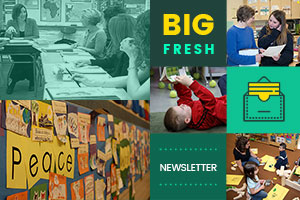Admiration and familiarity are strangers.
—George Sand
Making Meaning Together
Recently I was invited to lead a series of short professional learning sessions at the school where I started my teaching career 25 years ago. Each week we gathered in the section of the media center where decades ago I learned how to create conditions to support independence in my students as readers.
I was surprised by the number of memories that flooded me in this space that used to be a staple in my weekly routine. I remembered how all I wanted to do was teach middle school for the duration of my career, but instead an unexpected path unfolded. Still, the roots valuing the choice and voice of all students (and educators) were nourished within the walls of this school.
Many new faces entered the space, and those who were living my dream of remaining in one school for the duration of their careers greeted me with warmth and hugs.
Although there was the familiarity of coming home, I reminded myself I was a guest, charged with nourishing a straightforward, honest, and useful conversation about writing in all subject areas. It is a conversation I often facilitate and one of my favorite topics, even though I know it pokes some beliefs about instructional practices.
Our conversation focused on the importance of students learning content, and the way writing can be a tool to support their learning. Writing uncovers what we know, and more importantly what we do not know. We shifted our conversation to practical moves we can make. What happens when students don’t write? What do we do when they believe misconceptions? How do we grade student writing when we’re not English teachers?
We often hear, “You cannot be a prophet in your own land,” meaning that those who know us best tend to resist accepting our messages. I held this cautionary tale, and stiffened my heart as I opened the reflection from our first session. As I skimmed the responses, I lurched to a stop as my eyes brimmed with tears. Someone had written this:
Ruth still remembers what it is like to be in the classroom with students. This is often not the case with people who present information to teachers.
Over the course of our time together, people shared with me the way they tried out the ideas we discussed in our sessions. Others gave me the gift of warmly remembering our work together when I coached in their classrooms. Others shared with me their own journeys of learning to use writing to help students deepen their understandings of content.
Before you think it was all rainbows and sunshine, I must admit that I did share a reading that fell flat when I put the text “in play” with the staff. Initially I felt embarrassed, knowing that I should have set the stage better than I had. Yet, when we came together the next week, we were able to have a candid conversation about what happens when a text falls flat with our students. What happens when the reading doesn’t happen?
George Sand said, “Admiration and familiarity are strangers.” This is often true. However, when they learn to exist together, powerful connection happens. This week we focus on the importance of making meaning—plus more, as always.
Shine on,
Ruth Ayres
Editor in Chief

An overload of information, initiatives, and issues fill our days, and it is easy to become disorganized and distracted. With a coach’s notebook, you can organize professional interactions and support your own well-being. Be productive and wholly present for the things that matter most in your school—teaching and learning. Click here for registration and more information.

Aaliyah El-Amin, Scott Seider, and Julia Bott pair social analysis with concrete action to empower students to become agents of change in their communities.
Sarah Valter shows how to center book clubs in today’s literacy classrooms.
Gretchen Schroeder shares three meaningful ways to incorporate drawing into her high school English classes, and the purpose behind each strategy.
If you’re an instructional coach, we’d love for you to join our FREE coaching network called Coach-to-Coach. This simple and mighty group is led by Ruth Ayres and hosted by our sister site, The Lead Learners. The next meeting is Tuesday, February 18, at noon EST. Click here to register.

New members-only content is added each week to the Choice Literacy website. If you’re not yet a member, click here to explore membership options.
Gretchen Schroeder creatively leads her students in chronicling key scenes from a novel so they can evaluate which ones are important and use it as a reference throughout their discussions.
Josie Stewart and Hannah Tills push against the adage that “early readers are focused solely on learning to decode, while later readers are making meaning.” Instead they remind us of the beautiful way all readers are meaning makers.
Ruth Ayres explains the way image, text, and sound work together to create meaningful writing. She helps us consider where the writing carries the most meaning, as well as how these modes work together.
Book Guide | Big, written and illustrated by Vashti Harrison, is the story of a young girl who receives many messages about what it means to be big and which of those messages she chooses to own.

New members-only content is added each week to the Choice Literacy website. If you’re not yet a member, click here to explore membership options.
Matt Renwick shares with us a wise and helpful response when a teacher is looking for support for using a text with mature content in her classroom. Learn about book rationales, how to find them, and how to create one of your own with ChatGPT. More importantly, consider how to engage in conversations rather than offer blanket mandates about whether a book is allowed in classrooms.
David Pittman offers several ways to make the work of PLCs visible to everyone. The more open we are with our growth, the more connections we make, the stronger every educator becomes.
Coaching Minute | Curriculum director Inga Omondi understands the tension that can build in meetings. She offers advice for instructional coaches on what to do after a tough meeting.
Quote It:
The only way to change someone’s mind is to connect with them from the heart.
—Rasheed Ogunlaru
That’s all for this week!



